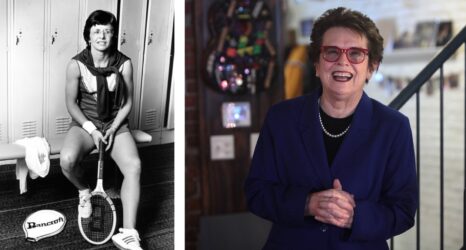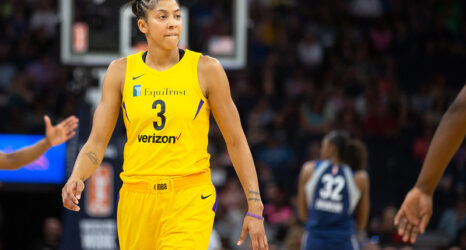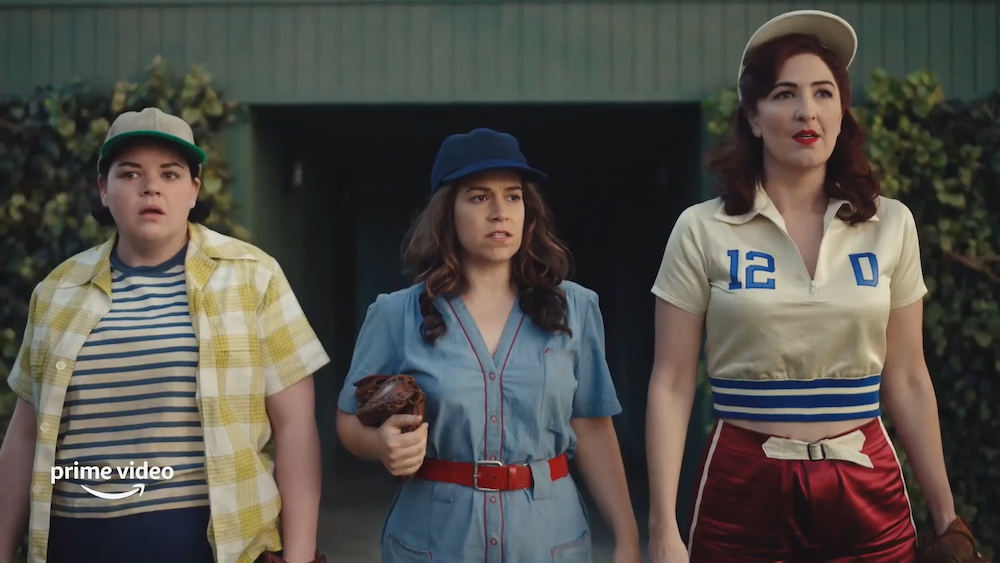
“There’s no crying in baseball,” says Tom Hanks in A League of Their Own. But the film’s more subtle theme is that there are no lesbians in baseball. The 1992 film made no mention of the fact that many of the athletes in the All American Girls Professional Baseball League (AAGPBL) were gay—although none of them were open about their sexuality except to close friends and some teammates. Reflecting the homophobia of the period, one 1943 magazine article expressed concern that the AAGPBL players would turn women’s baseball into an “uncouth Amazonian spectacle.”
But last Friday, Amazon Prime Video unveiled an eight-episode series, also called A League of Their Own, that includes openly lesbian AAGPBL players. It was co-created by Will Graham and Abbi Jacobson, who stars as Carson Shaw, a catcher for the AAGPBL’s Rockford Peaches. The show follows the lives of Peaches players on and off the field. Rosie O’Donnell, who was in the 1992 film, plays the owner of a gay bar.
The show breaks from the earlier film in another way. The AAGPBL never had a Black player, even after Jackie Robinson broke baseball’s color barrier with the Brooklyn Dodgers in 1947. Prohibited from playing in the AAGPBL, three African American women—Toni Stone, Mamie “Peanut” Johnson and Connie Morgan—played in the otherwise all-male Negro Leagues.
The new TV series includes Black players, but they play on an otherwise all-male Negro League team, not in the AAGPBL.
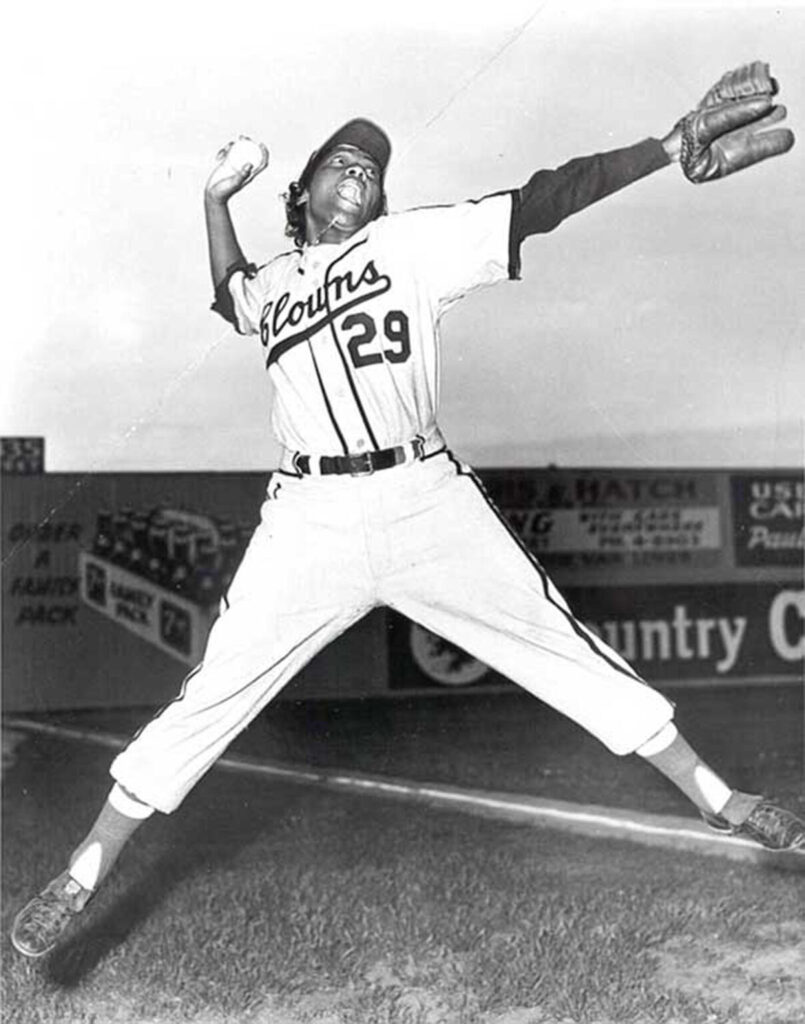
The AAGPBL, which lasted from 1943 through 1954, had been almost forgotten until 1987, when Kelly Candaele made a public television documentary called A League of Their Own, based in part on the experiences of his mother, Helen Callaghan, who played for three AAGPBL teams in the ’40s. Candaele’s film inspired director Penny Marshall to make a Hollywood version with the same title.
According to Candaele, “My mom … told me that she didn’t even know about lesbianism until she joined the Minneapolis Millerettes. She said that all the players knew that gay relationships in the league were common, but also that nobody seemed to make much of it.” Among his mother and her fellow players, Candaele said, “their attitude seemed to be that what happens within the team stays within the team.”
The AAGPBL was founded by Philip K. Wrigley, owner of the Chicago Cubs. Wrigley figured that baseball fans might buy tickets to see women play the game while many of their favorite major league stars were in the military during World War II.
Many AAGPBL players were recruited from softball teams, which had exploded during the 1930s and ’40s, but Wrigley insisted that the AAGPBL play regular baseball. The league started with four teams—the Racine Belles and Kenosha Comets (Wis.), the Rockford Peaches (Ill.), and the South Bend Blue Sox (Ind.)—and grew to 10 teams. In its 12 years, over 600 players filled the league’s rosters.
Because many of the best ballplayers were lesbians, the league could not exclude them. But AAGPBL executives insisted that the teams avoid the perception that any players were lesbians. The league handbook required players to radiate the “highest ideals of womanhood” and “dress, act, and carry themselves as befits the feminine sex.” The AAGPBL expected players to “Play like a man, look like a lady”—or, as player Lois Youngen put it, “Look like Betty Grable and play ball like Joe DiMaggio.”
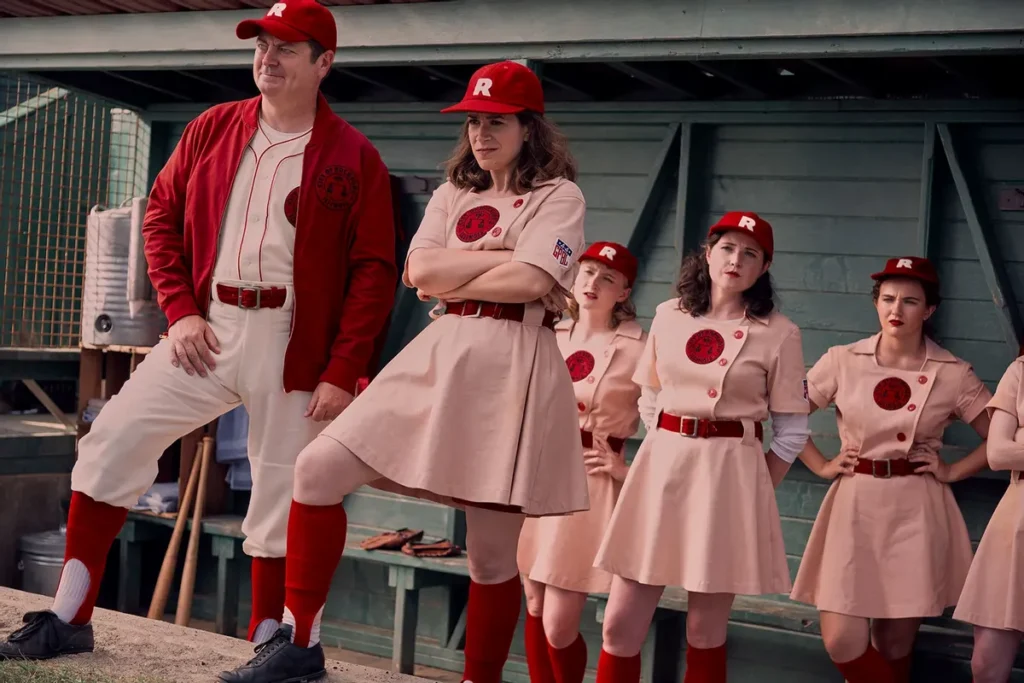
They played in flared skirts like those worn by women in figure skating, field hockey and tennis, even though they were expected to slide—which led to many bruises. Players were prohibited from smoking or drinking in public, required to get their chaperones’ permission for “all social engagements,” and obeyed a curfew. The league sent player profiles to local newspapers that focused not only on their playing skills but also their domestic hobbies, such as cooking and sewing. Players had to attend classes run by Helena Rubenstein’s charm school that included makeup tips, etiquette, language, posture, social skills and personal hygiene.
Connie Wisniewski—a five-time All-Star player from 1944 to 1952—was told that she would be released if she got a close-cropped haircut. Dottie Ferguson, a player between 1945 and 1954, was warned not to wear Oxford shoes because they were too masculine.
Many AAGPBL players were married, engaged or had boyfriends back home or in the military. However, some had affairs during the baseball season—with men and women, including teammates. League officials monitored the players’ behavior and punished those who engaged in same-sex relationships or even had the appearance of being lesbian.
One manager released two players whom he suspected were lesbians, worried that they would “contaminate” other players. When AAGPBL publicity director Fred Leo learned that a married player was having an affair with another woman, he contacted the player’s husband, who came and took her home.
Most players were from working-class families. Their salaries which initially ranged from $45 to $85 a week—were considerably higher than those of most jobs available to women, including jobs in defense plants. Even so, most had to work during the off-season, in factories or at office jobs.
While only 8.2 percent of women of their generation earned college degrees, 35 percent of AAGPBL players earned college degrees, with 14 percent earning graduate degrees. Many became teachers, coaches and advocates for women’s sports.
Some players had lesbian relationships during and after their playing days but remained closeted. Most came out of the closest after they died, through phrases in their obituaries like “long-term companion.”
The lesbian stereotype about women athletes persisted for many years. When tennis star Billie Jean King came out of the closet in 1981, it sparked a major controversy, and she lost many endorsements. But feminism and the LBGTQ+ movement have impacted the world of sports. Today, many lesbian athletes are open about their sexuality. As the stigma has eroded, fewer straight women athletes are worried about the stereotypes.
Maybelle Blair was an accomplished softball player when she joined the AAGBPL’s Peoria Redwings in 1948. After she suffered an injury, she moved to Chicago to play professional softball, then worked for Northrop Corporation for 37 years. She maintained her ties to the AAGPBL, serving on its alumni board of directors and encouraging girls and women to participate in sports.
During that time, she kept her sexuality a secret. But in June 2022, on stage at the Tribeca film festival premiere of the new Amazon series, the 95-year-old Blair came out. She was inspired by the show’s unapologetic acknowledgement of some players’ lesbianism.
“I think it’s a great opportunity for these young girl ball players to come to realize that they’re not alone and you don’t have to hide,” she said about the film. “I hid for 75, 85 years, and this is actually, basically the first time I’ve ever come out.”
For the majority of her life, sports legend 95-year old @AAGPBL player, Maybelle Blair felt like she had to hide her authentic self. Today she came out publicly for the first time. We couldn’t be happier for her, and continue to push for love and acceptance on and off the field. pic.twitter.com/BEaCisO2RH
— A League of Their Own (@LeagueOnPrime) June 14, 2022
After the AAGPBL folded in 1954, there were few opportunities for girls and women to play baseball—which changed after Congress passed Title IX in 1972. Little League, which had banned girls since it began in 1939, revised its charter in 1974 to allow girls to play. Girls’ participation in Little League was boosted in 1976 when actress Tatum O’Neal starred as the only girl on her Little League team in the film ”Bad News Bears.”
Since then, the number of girls and women participating in sports—from childhood through the professional ranks—has skyrocketed. The number of high school girls playing softball grew from 110,140 to 362,038 between 1982 and 2018. The number playing in college has grown from 7,465 to 20,316. These numbers don’t include the growing number of women participating in college club sports and amateur or professional leagues around the country. Women’s Professional Fastpitch, a pro softball league which began play this year, is the latest.
In 1996, Justine Siegal started Baseball for All (BFA), a nonprofit organization, now supported by Major League Baseball, to encourage girls to pursue baseball (not softball) beyond Little League. Last month, BFA held its seventh national tournament for 400 girls from 6 to 16 at Bell Bank Park in Mesa, Ariz.
In March, BFA held the first Women’s College Club Championships, with teams from California State University at Fullerton, Montclair (N.J.) State University, Occidental College, and the University of Washington.
On Aug. 13 and 14, 28 women participated in BFA’s Women’s College Baseball Invitational at Boston College to prepare for college baseball on both all-women and all-male teams. This spring, eight women are expected to play on all-male college teams—an all-time peak.
Some women have even played professional minor league baseball. Ila Borders—the first woman to receive a scholarship for men’s college baseball—played in several professional minor leagues from 1997 to 2000. She stayed in the closet until after she left baseball.
Kelsie Whitmore was the only female on her high school baseball team in Temecula, California. She played softball for Cal State-Fullerton, and led the U.S. Women’s Baseball team to a gold medal at the Pan American Games in 2015 and 2019. This season, the 24-year-old Whitmore is the only woman player on an all-male professional baseball roster. She’s pitching and playing outfield for the Staten Island FerryHawks in the independent Atlantic League, one or two rungs below the majors.
The only woman to play in the major leagues so far has been Genevieve “Ginny” Baker, who pitched for the San Diego Padres on the fictional TV series Pitch in 2016. While Fox canceled that show after one season, the makers of Amazon’s A League of Their Own are hoping that the eight episodes are only the first of many seasons.
U.S. democracy is at a dangerous inflection point—from the demise of abortion rights, to a lack of pay equity and parental leave, to skyrocketing maternal mortality, and attacks on trans health. Left unchecked, these crises will lead to wider gaps in political participation and representation. For 50 years, Ms. has been forging feminist journalism—reporting, rebelling and truth-telling from the front-lines, championing the Equal Rights Amendment, and centering the stories of those most impacted. With all that’s at stake for equality, we are redoubling our commitment for the next 50 years. In turn, we need your help, Support Ms. today with a donation—any amount that is meaningful to you. For as little as $5 each month, you’ll receive the print magazine along with our e-newsletters, action alerts, and invitations to Ms. Studios events and podcasts. We are grateful for your loyalty and ferocity.
Up next:




